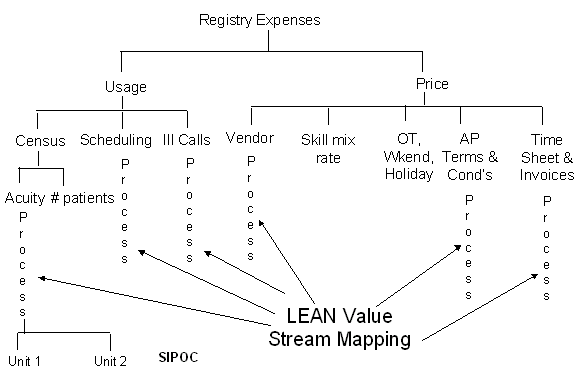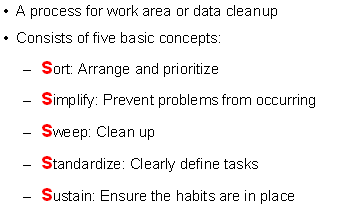
Since its introduction nearly two decades ago, Six Sigma has been embraced by many organizations and industries involved in manufacturing and transactional services as a cost-effective way to improve quality and productivity. As a method to eliminate variation and defects, Six Sigma makes use of a structured approach and statistical tools to find the root causes behind problems and to drive processes toward near-perfection.
As a technical strategy that complements the strengths of Six Sigma, Lean utilizes a unique set of tools to streamline processes and eliminate unnecessary, time-consuming steps. It seeks to enhance performance and meet customer needs by reducing complexity, improving process flow and removing unnecessary or non-value added work or muda – the Japanese term for waste.
How Does this Relate to Healthcare?
Since waste and inefficiency can creep into virtually any process, the concept of muda in Lean terminology and variation in the Six Sigma vernacular are equally applicable to healthcare systems and services. This does not imply, however, that a certain amount of translation and adaptation are unnecessary. On the contrary, taking any improvement approach into the special realm of patient care – regardless of what it’s called or where else it has worked – requires sensitivity, knowledge and experience relative to the unique needs within the healthcare environment. Once this translation has taken place and the approach has incorporated techniques that address the human or cultural aspects involved, improvements in healthcare can be accelerated and sustained.
A successful Lean Six Sigma project delivers a streamlined process by helping to identify and eliminate work required that is of low value in meeting the CTQs (critical to quality) or elements that are critical to quality for the customer. In the healthcare environment, the customer may be the patient, family, physician, nurse, administrator or any other stakeholder in the process. Understanding their individual requirements is key to creating the right project structure and scope.
Using Two Key Tools of Lean
Two key Lean tools which are proving to work well in hospitals are Value Stream Mapping, which visualizes process flow, patient flow, information flow and key throughput data on one document and 5S’s – a process simplification and process cleanup tool. Utilization of these two tools has been instrumental in yielding project benefits at Nebraska Health System and Good Samaritan Hospital in Los Angeles. Other Lean tools such as visual process management, kitting and setup time/changeover reduction also are blending well with Six Sigma efforts in healthcare.
There are many examples demonstrating the application of Lean techniques in conjunction with Six Sigma in healthcare. At Good Samaritan Hospital in Los Angeles, the combined methods are driving results in procurement and nursing registry projects. The chart below illustrates Lean value stream mapping as applied to the registry project at Good Samaritan.


To improve bed availability at Nebraska Medical Center, Black Belt Matt Pospisil utilized the Lean Six Sigma methodology and was able to achieve a 20-minute reduction in patient “time to bed after bed assignment.” Through the process of value stream mapping and 5-S, Pospisil was able to identify and remove the non-value added work associated with faxing the patient summary sheet to the receiving floor, as well as simplify, combine and eliminate various other forms, approvals, phone calls and pages. As a result of this particular project, Nebraska Medical Center realized significant benefits and gained additional capacity for 80 patients per year valued at more than $350,000 in annual revenue.
This combined approach also is being applied to address a variety of challenges at Valley Baptist Health System in Harlingen, Texas, Yale-New Haven Hospital in Connecticut, Boston Medical Center, Cincinnati Mercy and Cincinnati Children’s Hospital, among other facilities.
Lean complements Six Sigma and change management by providing an effective and efficient method to analyze larger, more complex processes, in some cases adding speed to the traditional Six Sigma approach. Both methodologies share common concepts such as poke yoke or mistake proofing, and both attack complex problems with a team that follows a logical thought process, utilizes data and makes fact-based decisions to solve a problem.
A hybrid between a Six Sigma project and Lean combines aspects of both methodologies. Individually, both methodologies are effective for problem solving. Collaboratively, they become much more powerful.
As the power curves below depict, Six Sigma is strong in the Define, Measure and Analyze phases and defining the Big Ys and Critical Xs, but may not clearly demonstrate the sustainable and repeatable solutions for the Improve and Control stages. Lean tends to be very strong in the phases of Define, Improve and Control. Where Six Sigma is very data driven, Lean is a visual and hands-on lending itself to faster process solutions.

Combining Six Sigma and Work-out
Six Sigma uses a five-phase project methodology (either DMAIC [Define, Measure, Analyze, Improve, Control] or DMADV [Define, Measure, Analyze, Design, Verify]) that is well suited to solving complex problems where the causes are unknown. The team uses data to find the vital few causes (X) that impact a problem (Y) using statistical tools like design of experiment, hypothesis testing and so on. With an understanding of the Y = f(X) relationship, the team can then statistically validate an improvement.
By contrast, the methodology known as Work-out is typically used to solve complex problems where the causes are more evident. The project team will still use data to make fact-based decisions, but will quickly identify waste in a process and make changes by “try-storming” as opposed to detailed data analysis.
In some cases, the two methodologies may be combined into a hybrid process. The team uses Six Sigma methodology to find the vital few causes of a problem and then fixes the problem with Work-out that focuses on team activity. In both cases, the methodology can drift from complex to straight-forward solutions if a more focused effort is needed.
In a Six Sigma project, a team will typically expend a moderate amount of effort over a longer period of time. Data collection and analysis is by its very nature a time consuming activity. After implementing an improvement, the team also takes time to collect the data to statistically validate changes that were made.
In Work-out, a team will typically focus a large amount of activity over a one-week period. Since the causes are clearer, the team can focus more activity on improvements. Using a process of “try-storming” (20 percent think, 40 percent do and 40 percent re-do) rather than brainstorming helps to rapidly change the process and make additional improvements as needed. This is an effective way to quickly drive change and generate energy behind improvements.
One way to think about how to prepare for and execute Work-out is by using the familiar DMAIC methodology. All of the tasks associated with the Define, Measure and Analyze (DMA) phases should be complete prior to the AWO. The specific deliverables for each phase may differ somewhat from a Six Sigma project, but both the intent and results are the same. Typically the DMA portion of Work-out is completed within three weeks. Elements of the Improve and Control phases should be completed during Work-out. Once again, the specific deliverables for each phase may differ slightly from a Six Sigma project.
The idea is to learn by doing: quickly analyze a situation, decide on a course of action, implement changes and make revisions as necessary. One way to judge the success of Work-out is by the number and type of action items to be completed after the week. The fewer items left unfinished after the Work-out week, the better the Work-out.
Ten Rules of Work-out
- Discard conventional ideas
- Think of how to do it, not why it cannot be done
- Question everything…no excuses
- Start to solve it now…immediate perfection is not expected
- Correct mistakes at once
- Spend money wisely
- Best solutions surface when faced with hardship
- Ask “why” at least five times
- Look for ideas everywhere
- Ideas are infinite – try them out
Summary
Strategically blending the best elements of Six Sigma, Lean and Work-out is proving to be an effective approach for increasing productivity and optimizing performance in healthcare. Achieving results where other initiatives have failed, application of such combined techniques takes into account the special nature of patient care delivery and the complex environment within any healthcare provider organization.
Although it is not always easy to admit pockets of inefficiency within our own organizations, it has become increasingly important to make such assessments based on credible information. In healthcare, where resources are often scarce and time is a precious commodity, it is imperative to make every process as lean and defect-free as humanly possible. Lean Six Sigma methods combined with change management techniques are helping some healthcare organizations inch closer to this goal.